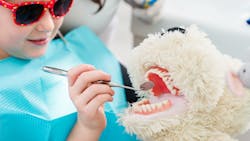New grads’ guide to the pediatric patient
A degree in applied sciences couldn’t be more fitting for the study of dental hygiene. The dental hygiene career is a true application of the concepts taught over a comprehensive two-year program. Working as a dental hygienist is fast paced and hands-on. As a student or recent graduate, entering the working world may feel overwhelming. The reality is that you possess the knowledge and have the clinical skills, but how do you build confidence in your career and effectively communicate with patients? New grads’ guide to… is a monthly article on different dental hygiene topics for students or recent graduates to review and feel empowered in the clinical setting.
I have worked as a dental hygienist in a cosmetic practice for five years. I was recently approached by a pediatric office asking if I would fill in on my days off. I realized if I am going to work exclusively with pediatric patients, I want to be an expert at it! February is National Children’s Dental Health Month, so what better time to review the basics of the pediatric patient!
If you don’t often work with children, reviewing the grade associated with each age is a helpful frame of reference for choosing appropriate verbiage when talking to the patient:
- Age 3-5 | Preschool
- Age 5-6 | Kindergarten
- Age 6-7 | First grade
- Age 7-8 | Second grade
- Age 8-9 | Third grade
- Age 9-10 | Fourth grade
- Age 10-11 | Fifth grade
- Age 11-12 | Sixth grade
Desensitization of dental terminology
- Explorer | tooth counter
- Air syringe | wind
- Slow-speed suction | Mr. Thirsty
- High-speed suction | Mr. Vacuum
- Polisher | tooth tickler
- Fluoride | tooth vitamins
- Sealant | tooth paint
- X-ray | tooth picture
- Hurt/pain | bother
Quick references for mixed dentition1
- Primary mandibular central incisors are the first to erupt at around 6–8 months; all primary teeth should be erupted by age 2½.
- Primary teeth mnemonic: Apple Jacks Kill Teeth (all primary second molars).
- The first permanent teeth to erupt are the “6-year molars,” or permanent first molars (nos. 3, 14, 19, 30). The first permanent molars do not replace any primary teeth.
- Permanent premolars replace primary molars, typically around 10–12 years old.
- All primary teeth are typically lost between the ages of 12–14.
Eruption issues2
- Eruption hematoma – blue/purple blood-filled swelling over an erupting tooth, typically asymptomatic and requires treatment only if patient is experiencing pain or difficulty eating.
- Retained primary tooth – a tooth that is retained longer than typical eruption time. Typically caused by congenitally missing tooth (born without permanent tooth) or ankylosed tooth (fusion between alveolar bone and cementum of tooth).
- Ectopic eruption – tooth does not follow its normal eruption course.
Teething tips3
- May cause increased drooling, the desire to bite/chew, and mild pain.
- Parent may massage gums with chilled (not frozen) washcloth or chilled (not frozen) rubber teething rings.
- Avoid teething gels/tablets that are not FDA approved due to dangers with ingesting ingredients such as benzocaine and alcohol.
Oral habits4
- Thumb-sucking or use of pacifier beyond the age of 3 can interfere with palatal development and eruption of permanent teeth. Provide positive alternatives such as counting teeth with tongue, sucking on washcloth until habit is broken, a thumb guard, or ADA-approved nail paint.
Dental caries5
- The structure of enamel contains channels through which calcium and fluoride minerals, as well as acids, flow. Teeth are constantly seeking equilibrium between demineralization and remineralization. During demineralization, acid attacks lower the pH level of the tooth structure, and calcium and phosphate diffuse out of the enamel, resulting in an early carious lesion.
- Frequency of acid exposure is more detrimental than quantity consumed; review nutritional counseling with parent.
Fluoride6
- Fluoride reverses the caries process by remineralizing/hardening the enamel structure through the release of calcium and phosphate.
- Use rice-sized amount of fluoride paste at first tooth eruption for infants under 3 years old, pea-sized amount of fluoride paste for ages over 3.
- Identify child’s primary water source and if it contains fluoride.
- Avoid fluoride mouth rinse until child can successfully expectorate.
Oral hygiene7
- Wipe infant’s mouth with soft cloth at least once a day prior to teeth erupting.
- Brush with washcloth, soft brush, or finger cot aid using fluoride paste twice daily once the first tooth has erupted.
- Parents should start flossing child’s teeth when adjacent teeth are touching. Platypus flossers or water flossers can be used for ease of flossing with ortho.
Confidence is key to success when treating patients in clinical practice. Consider printing this article and keeping it in the cupboard of your operatory. The next time you complete a chart audit and see a 6-year-old patient on the schedule, do not stress! Use this guide for reference, and continue to provide the highest standard of hygiene care.
References
- American Dental Association. Tooth eruption: the primary teeth. J Am Dent Assoc. 2005;136:1619. doi:https://www.ada.org/~/media/ADA/publications/Files/patient_56.pdf
- Eruption problems: smiles for tomorrow. American Academy of Pediatric Dentistry. Mar. 26, 2018. www.dentalcare.com/en-us/professional-education/ce-courses/ce04/eruption-problems#:~:text=An%20eruption%20hematoma%20presents%20as,spontaneously%20and%20require%20no%20treatment. Accessed February 1, 2021.
- Soothing teething pain and sensory needs in babies and older children. US Food and Drug Administration. May 23, 2018. www.fda.gov/consumers/consumer-updates/safely-soothing-teething-pain-and-sensory-needs-babies-and-older-children. Accessed February 1, 2021.
- Johnson SK. Bad-habit rehab. Parents. 2010;50–54. doi:https://www.aapd.org/assets/news/upload/2010/4110.pdf. Accessed February 1, 2021.
- American Academy of Pediatric Dentistry. Policy on early childhood caries (ECC): classifications, consequences, and preventive strategies. The Reference Manual of Pediatric Dentistry. 2020:79–81.
- American Academy of Pediatric Dentistry. Fluoride therapy. The Reference Manual of Pediatric Dentistry. 2020:288–291. Accessed February 1, 2021.
- American Academy of Pediatric Dentistry. Frequently asked questions (FAQ). 2021. www.aapd.org/resources/parent/faq/. Accessed February 1, 2021.
Dara McConnell, MBA, RDH, is a practicing dental hygienist and digital media marketer. Active in the fitness community from obstacle course racing to American Ninja Warrior, Dara loves relating oral health to overall health and wellness. She uses her digital media platform to connect with current dental hygiene students and recent graduates, providing quick tips to ensure clinical success.
About the Author

Dara McConnell, MBA, RDH
Dara McConnell, MBA, RDH, is a practicing dental hygienist and digital media marketer. Active in the fitness community from obstacle course racing to American Ninja Warrior, Dara loves relating oral health to overall health and wellness. She uses her digital media platform to connect with current dental hygiene students and recent graduates, providing quick tips to ensure clinical success. She also likes to apply the financial principles from her master’s degree to personal money management, especially for other dental professionals.

